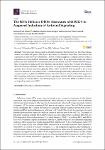The RNA Helicase DDX6 Associates with RIG-I to Augment Induction of Antiviral Signaling
Núñez, Rocío Daviña
Budt, Matthias
Saenger, Sandra
Paki, Katharina
Arnold, Ulrike
Sadewasser, Anne
Wolff, Thorsten
Virus infections induce sensitive antiviral responses within the host cell. The RNA helicase retinoic acid-inducible gene I (RIG-I) is a key sensor of influenza virus RNA that induces the expression of antiviral type I interferons. Recent evidence suggests a complex pattern of RIG-I regulation involving multiple interactions and cellular sites. In an approach employing affinity purification and quantitative mass spectrometry, we identified proteins with increased binding to RIG-I in response to influenza B virus infection. Among them was the RIG-I related RNA helicase DEAD box helicase 6 (DDX6), a known component of cytoplasmic mRNA-ribonucleoprotein (mRNP) granules like P-bodies and stress granules (SGs). RIG-I and DDX6 both localized to the cytosol and were detected in virus-induced SGs. Coimmunoprecipitation assays detected a basal level of complexes harboring RIG-I and DDX6 that increased after infection. Functionally, DDX6 augmented RIG-I mediated induction of interferon (IFN)-β expression. Notably, DDX6 was found to bind viral RNA capable to stimulate RIG-I. These findings imply a novel function for DDX6 as an RNA co-sensor and signaling enhancer for RIG-I.
Dateien zu dieser Publikation

